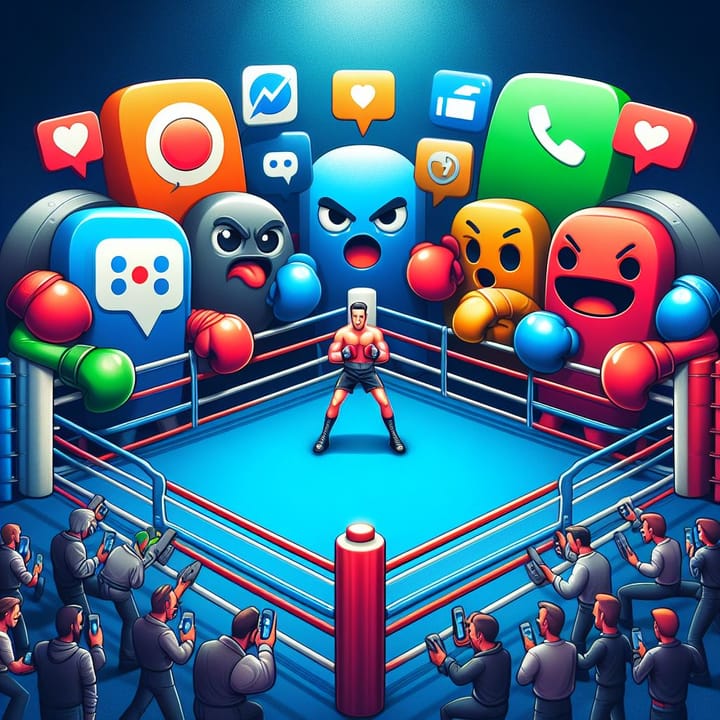Looking at Decentralised Identities and how individuals own, control, and share their identity information without the need for a central authority.
LISTEN TO THE AUTHOR X SPACE
Decentralized Identity (DID) is a concept within the Cypherpunk movement that revolves around individuals having control over their own identity without relying on centralized authorities.
In this article we will look at the key aspects:
The Potential of Self-Sovereign Identities:
Self-Sovereign Identity (SSI) is about giving individuals full control over their personal information. It means you own and manage your identity without relying on central authorities like governments or corporations.
Here's a simplified breakdown:
- Ownership: You own it. It's not stored in a central database controlled by someone else. Think of it like having a digital wallet for your personal details.
- Control: You decide who gets access to what. You share only the necessary parts, like proving your age without revealing your exact birthdate.
- Privacy: SSI is designed to keep your information private. You're not part of a massive database that could be hacked. Instead, your data is secure, often using advanced technologies like blockchain.
- No Middlemen: Traditional systems often involve middlemen, like banks verifying your data. SSI cuts out the middle, allowing direct interactions between you and whoever needs to confirm your identity.
- Flexibility: Your digital identity should work across different platforms. SSI aims to be flexible and usable across various services without needing to create a new identity for each one.
In essence, SSI puts you in the driver's seat of your digital identity, emphasizing control, privacy, and simplicity.
Various solutions and what they aim to achieve:
SSI solutions aim to revolutionize how we manage and control our digital identities. These solutions, often built on blockchain technology, empower individuals with ownership and authority over their personal information. Platforms like Sovrin, uPort, and Microsoft's Identity Overlay Network (ION) offer tools for users to create, store, and selectively share their attributes without relying on central authorities. The goal is to eliminate the need for traditional forms of identification, such as usernames and passwords, and enable more secure, private, and user-centric digital interactions.
Benefits and drawbacks:
The adoption of these solutions comes with notable benefits and drawbacks. On the positive side this offers enhanced user privacy by allowing individuals to selectively disclose personal information, reducing the risk of unauthorized access and data breaches. However, challenges include potential resistance to change from established systems, the need for widespread adoption for full effectiveness, and the risk of individuals mishandling the responsibility of managing their private keys. Striking a balance between user empowerment and ensuring a smooth transition from traditional systems represents an ongoing challenge in the widespread implementation.

Can blockchain technology be used for digital identities?:
What are the benefits of using Blockchain?
DID often uses blockchain tech. Blockchain is like a secure digital ledger, making sure no one messes with your information. It's resistant to tampering, so your data stays safe. Plus, it's transparent, meaning you can easily see what's happening. With blockchain, you're in charge of your digital identity and transactions.
Here's how it plays a key role:
- Secure Digital Ledger: Blockchain acts like a super-secure, digital ledger or record-keeping system. Information is stored in blocks, and these blocks are linked together in a chain. Once a piece of data is in a block, it's tough to change without altering all the subsequent blocks, making it tamper-resistant.
- Data Integrity: The tamper-resistant nature of blockchain ensures the integrity of your data. Once your information is recorded, it's practically impossible for someone to sneak in and make unauthorized changes without everyone noticing. This helps in maintaining the accuracy and reliability of the information.
- Transparency: Blockchain is transparent by design. Every participant in the network has access to the same information. This transparency ensures that there's a shared view of the data, reducing the chances of disputes or discrepancies.
- Decentralization: Traditional systems often rely on a central authority to manage data. In blockchain-based decentralized identity, there's no single point of control. Instead, the network is distributed across many computers (nodes), making it more resilient and less susceptible to hacking or unauthorized access.
- Enhanced Security: The use of cryptographic techniques in blockchain ensures a high level of security. Information is encrypted, making it difficult for unauthorized parties to gain access.
Blockchain provides a robust and trustworthy foundation for decentralized identity systems, offering security, transparency, and user control.
What are the potential drawbacks of using Blockchain?
While blockchain may play a crucial role in decentralized identity systems, certain drawbacks exist. One significant concern is the challenge of balancing privacy and transparency. While blockchain ensures the security and immutability of data, the inherent transparency might expose sensitive information if not managed carefully. Scalability is another issue, as the decentralized nature of blockchain networks could lead to slower transaction processing times, affecting the responsiveness of decentralized identity systems. The reliance on cryptographic keys introduces a risk of key loss, potentially resulting in permanent loss of access to one's data. Additionally, the legal and regulatory issues in this space is still evolving, and uncertainties may pose obstacles to widespread adoption. Addressing these challenges is crucial for the successful integration of blockchain into decentralized identity frameworks while maintaining user privacy, scalability, and compliance with regulatory standards.
The trade-off - Convenience, Privacy, Security:
Privacy Preservation:
DID is all about giving you control over what you share. Here's how it increases your privacy:
- Selective Disclosure: Instead of handing out your entire identity like a business card, DID lets you be picky. You can choose specific details or credentials to share, keeping the rest under wraps. It's like showing your ID without revealing your home address.
- Need-to-Know Basis: Only share what's necessary. If someone just needs to confirm your age, that's all they get. No unnecessary details get thrown into the mix, keeping your personal info on a need-to-know basis.
- Reduced Data Collection: DID cuts down on the data hoarding. Traditional systems often scoop up more info than they need. With decentralized identity, the focus is on minimalism, collecting only what's essential for a particular interaction.
- User Empowerment: You're in charge. You decide who gets what, giving you the power to manage your digital identity. This approach puts a strong emphasis on user empowerment, ensuring that you're not at the mercy of entities collecting more data than necessary.
- Mitigating Surveillance Risks: By minimizing the information shared, DID acts as a shield against unnecessary surveillance. It aligns with the Cypherpunk principles of resisting unwarranted intrusion into personal lives.
In a nutshell, decentralized identity lets you share just enough to get things done while keeping the rest safely tucked away. It's privacy on your terms.
Can privacy be achieved?
Selective disclosure mechanisms allow users to share specific attributes without revealing their entire identity, reducing the risk of unnecessary exposure. While DID holds great potential for enhancing privacy, its effective implementation relies on careful design, robust encryption, and user education to prevent potential pitfalls or misuses of this technology.

Compatibility:
Compatibility in decentralized identity is like making sure different digital systems speak the same language. It's about ensuring that your digital identity can smoothly work across various platforms and services without any hiccups.
Imagine if your ID card only worked with one type of door lock. That would be inconvenient, right? Compatibility solves this issue. It means your decentralized identity can be recognized and used on different apps, websites, or services, just like your ID works wherever you go.
Imagine buying things online without constantly entering your details. Using blockchain, your payment details become tamper-resistant and transparent. No single authority holds all your financial info, reducing the risk of a massive data breach. This isn't just about security; it's about convenience. With a decentralized identity, online payments become more streamlined, less prone to fraud, and entirely under your control.
The key is having common standards and rules that everyone follows. This way, whether you're logging into a social media account, accessing a financial service, or using an online marketplace, your decentralized identity seamlessly fits. It's like having a universal key for your digital interactions, making things more convenient and user-friendly. Compatibility is the glue that holds together the vision of a decentralized identity.
However, if there's a lack of compatibility in decentralized identity, it's akin to digital systems speaking different languages, resulting in a fragmented and inconvenient user experience. In this scenario, your decentralized identity might struggle to smoothly navigate across various platforms and services, creating hiccups and complexities akin to having an ID card that only works with specific door locks.
Would security be an issue?
Security remains a critical consideration, primarily as these rely heavily on technologies like blockchain and cryptographic methods. Potential vulnerabilities may arise from implementation flaws, coding errors, or attacks on the underlying infrastructure. The use of cryptographic keys, while fundamental for user control, introduces risks if not adequately managed, with potential concerns related to key loss or theft. Additionally, the distributed and decentralized nature of these systems may pose challenges in ensuring uniform security standards across the entire network.
Understanding Single Points of Failure and the potential for Eliminating or Not:
Getting rid of single points of failure in decentralized identity is like making sure there's no one weak link that can mess things up. Think of it as spreading your eggs across different baskets instead of putting them all in one.
In traditional systems, there's often one central authority holding all the keys to your identity. If that authority gets compromised, it's like opening Pandora's box – a single breach can lead to a massive data disaster. Decentralized identity avoids this risk by spreading the responsibility. There's no single database or authority holding all the crucial info. Instead, it's distributed across a network of computers, making it much harder for a single mishap to cause a widespread identity catastrophe.
The argument against the elimination of single points of failure, particularly in the context of personal information stored on a blockchain, raises valid concerns about privacy and the potential for information exploitation. While a distributed ledger offers security against tampering, it also means that everyone on the network holds the same information. In the case of personal IDs, this can lead to a paradox where the decentralized nature becomes a single point of failure in terms of privacy. For instance, sharing specific details for a simple transaction, like buying a beer, might expose individuals to potential simulations or collusions for more comprehensive personal information. Blockchain might not be the ideal solution for storing personal information due to the cascading risks that arise once a fragment of data is compromised. In presenting a comprehensive view, it's essential to recognize these nuanced perspectives and acknowledge that blockchain solutions may not universally fit every context.
User-Centric Approach:
A user-centric approach in decentralized identity puts you in control. It's like having the remote control for your digital identity. Instead of being at the mercy of big companies or authorities, you're the boss.
Imagine logging into any online service without creating a new account each time. With a user-centric approach, you have a digital identity that's portable. It's like carrying your ID card, but for the internet. You decide what to share and when, giving you more control over your online interactions.
This approach aligns with the idea that your digital identity should serve you, not the other way around. It's all about convenience and empowerment. You don't have to remember a dozen passwords or deal with complicated sign-up processes. Your digital identity is yours, tailored to fit your needs and preferences. It's a shift from the traditional model where companies hold the reins – now, it's you calling the shots.
Convenience, the double edge sword:
Convenience in technology is a double-edged sword, offering unparalleled ease alongside potential risks. While innovations like biometric authentication, one-click payments, and streamlined user experiences enhance convenience, they also introduce concerns such as data security and privacy. The more seamless and interconnected our digital experiences become, the more we rely on storing personal information online, making individuals vulnerable to cyber threats and data breaches. Striking the right balance between convenience and security is crucial; prioritizing one over the other can lead to significant drawbacks. Therefore, as technology advances to make our lives more convenient, it is essential to implement robust safeguards, educate users on responsible practices, and continuously adapt security measures to mitigate potential risks.

Talking points from this article
There are many questions that must be asked. A large number downsides and obstacles must be overcome before we reach a destination where a DID is possible with safety, privacy and security. We aren't quite there yet but hopefully there is a place in the future that we can interact without the data being compromised, can control a lot more privacy than having the privacy on the companies side/servers.
A lot of unanswered questions that can be discussed:
- What data needs to be collected by DID and why?
- How is this data going to be used and how could systems like this mitigate the risks?
- Why it's a bad idea to store your internet data with your personal data?
- Should our personal data and identity be kept off the internet / blockchain entirely and why?
- What do protocol providers have to gain from building these platforms and collecting your data?
- What is the potential for backdoor Corp / Gov keys?
- What is the potential for your data to be harvested or sold on these new systems?
- What are the alternatives to storing your data?
- Can a data-less system be created for our internet persona?
- Why is it a bad idea to store personal data on-chain and what are the long term implementations?
Government-issued documents like passports, driver's licenses, and birth certificates are already widely accessible, raising concerns about the security and privacy of personal data. While addressing these issues at a government level is crucial, the idea of connecting personal data to online activities poses a significant risk to anonymity, privacy, and security. The vision here is to keep these entirely separate – a system where leaking internet data would leave no trace of one's real identity. Embracing Cypherpunk principles means scrutinizing any system that seeks personal data, as the link between personal and internet data undermines the very values of anonymity and privacy the Cypherpunk movement advocates for.
Conclusion:
In summary, decentralized identity aligns with the Cypherpunk philosophy by promoting user autonomy, privacy, and security. It envisions a future where individuals have more control over their digital identities. Imagine having a digital identity that's flexible, private, and works seamlessly across various online platforms. It's like having a key that fits perfectly into every digital lock you encounter.
Moreover, the interoperability of decentralized identity ensures that your digital persona isn't confined to a single platform – it travels with you. By eliminating single points of failure, the system becomes more resilient and less vulnerable to large-scale breaches.
In a user-centric world, you decide how, when, and where to use your digital identity. This Cypherpunk vision pushes us towards a future where individuals hold the reins of their digital lives, supported by secure, private, and user-friendly decentralized identity systems.
However, it's crucial to acknowledge that this utopian vision of DID is not without its challenges. The potential drawbacks include concerns about scalability, energy consumption, and the complex integration of blockchain technology. Achieving widespread adoption and navigating legal and regulatory uncertainties also present ongoing hurdles.
In conclusion, while decentralized identity holds immense promise, addressing these challenges is imperative to ensure a secure, private, and user-friendly evolution.






Comments ()